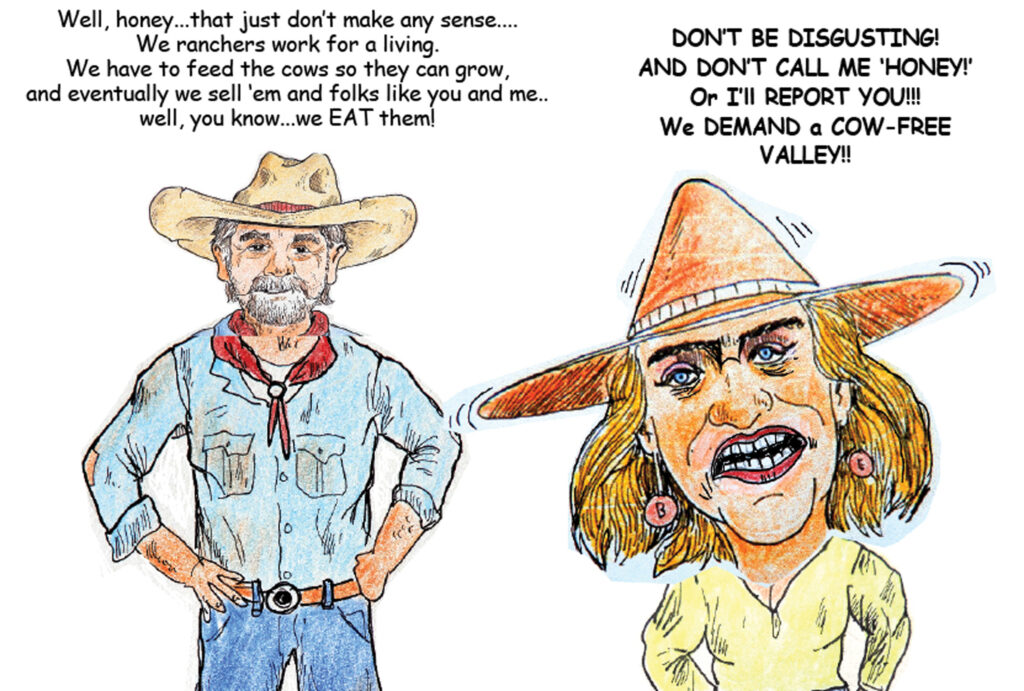Natural Assets: Monetizing the Air We Breathe

By Margaret Byfield
American Stewards of Liberty
A new international scheme is being launched in America based on the idea that intrinsic values in nature can be quantified and converted to become investment products. The Rockefeller Foundation founded the Intrinsic Exchange Group (IEC), which has partnered with the New York Stock Exchange to create a “natural asset” investment vehicle called “Natural Asset Companies (NACs).”
Their concept is that the air we breathe, the water we drink, and products we use that are derived from nature all have value that is not being considered by financial markets. IEC claims this value can be converted to new public investment vehicles like NAC.
At the same time, the Biden Administration is working to record the value of these natural assets on the federal balance sheet. In January, the Administration issued The National Strategy to Develop Statistics for Environmental-Economic Decisions: A U.S. System of Natural Capital Accounting and Associated Environmental-Economic Statistics. According to the report, new “Natural Capital Accounts” will be used to “quantify” nature’s value and list those values as new assets of the federal government.
This would provide a basis to increase the national debt and impose new fees and taxes on the American people. It will also establish the fixed and intrinsic value for the federally protected lands, positioning them to be enrolled in the private NAC accounts.
These efforts combined are intended to create an entirely new economy, virtually out of thin air. None of it should make sense to any serious investor. Investment products are based on tangible assets such as land, homes, and companies—things that have value because they can be secured and held by an owner to the exclusion of others, and that provide a benefit for which consumers are willing to pay. This new economy requires valuing things that no one has a right to own exclusively, such as breathable air.
The actual purpose of this plan seems to be to transfer the natural resource wealth held by America’s landowners to a green cartel that now includes IEC, the government, and special-interest environmental and conservation groups. From this perspective, the plan makes sense not as a wise investment for most Americans, but as a diabolical scheme to finance the growth of government while removing as much land from private citizens as possible.
How It Works
There is a glaring problem with the way IEC is selling its natural asset model, which is that no investment professional can explain how investors will make money. The problem is that IEC and the Biden Administration are pretending that fixed financial values can be placed on naturally occurring elements—including air—that cannot be held to the exclusion of others.
To fix this problem, the natural asset economy also places a financial value on services to protect nature. The economy includes a new industry category called “ecosystem services” that will support and protect the natural assets.
These NAC protected assets can be based on three types of land types: Natural (protected), Working (some productive uses highly regulated) and Hybrid (a mix of Natural and Working). They state the cashflow will come from “ecotourism revenue or carbon credit sales on natural lands and commodity crop production on working lands.” Revenue is also expected to come from “ecosystem services,” which they describe as the benefits derived from protecting the environment as well as the goods and services provided by entities that protect and manage the resources, such as environmental non-government organizations.
The NACs must have rights to fixed natural assets such as land, water, conservation easements, federally protected lands, and crops to offer exclusive rights to the intrinsic elements they claim are produced by protecting the area. The act of monetizing these intrinsic elements is what appears to be their basis for claiming this new economy will be four times larger than today’s economy.
For example, a forest will be reserved to sequester carbon dioxide, and will be managed by an ecosystem services’ provider. This way, the clean air and sequestered carbon are effectively converted from intangible assets to tangible assets, and the ecosystem services to protect them generate a new value that can also be financially quantified. These acrobatics are the basis for any returns that would be paid to investors in NACs.
Under this new plan, the value of the trees will be tied not to their potential for conversion to paper or construction material, but for sequestering carbon that can be sold in the form of carbon credits. The local economic contributors will shift from timber companies, which purchase equipment, fuel and other job-producing goods and services, to environmental service providers, which are the domain of non-profit environmental organizations, consultants, and biologists whose contribution will be to “protect” the resources.
The equity in natural asset companies will also include conservation easements on private land.
For example, the value of a conservation easement or development right sold to a land trust by a landowner is recorded on the land trust’s balance sheet. The 2022 financial report for The Nature Conservancy lists the asset value of the easements it owns at $2.5 billion. The examples IEG provides indicate that easements will be important tangible assets used to stand-up NACs. This can be done without a landowner’s consent because easements are a property right owned solely by the land trust.
Land trusts will earn direct income for the “ecosystem services” they provide, as well as receive payments from the conservation easements they own after they are enrolled in the NAC. They are poised to reap billions of dollars on the backs of America’s landowners.
But, Will It Work?
The natural asset industry admits that it does not produce anything that the natural world does not already contribute on its own, with or without their protection services.
Can the scheme work? Possibly, if our American society is fundamentally transformed.
First, citizens must believe we are in a climate crisis and that our exploitation of natural resources is the cause. For example, we must be convinced that too much man-made carbon dioxide is being pumped into the atmosphere, and then believe the cure for this is to set aside more forests to absorb the CO2. This creates public support to protect more forests for carbon sequestration.
Second, natural assets need to be valued acre-by-acre across America. An inventory must be taken of all lands and natural resources, including private and government lands, easements, wetlands and water, grasslands and crop lands, carbon sequestration areas and carbon sinks, and mineral reserves and energy resources. After that, a financial value must be placed on every single element in the inventory.
Third, every citizen must have an emission and credit account that tracks our impact on the climate—similar to carbon credits already being sold to corporations. If you drive an SUV, you pay more. If you drive an EV, you pay less.
Fourth, climate crisis advocates must gain control of federal agencies so voting citizens no longer determine the direction of national environmental policy. In addition, regulations must compel citizens to participate in the natural assets’ economy, such as by requiring electric stoves over gas stoves.
Fifth, the government must clear title to the lands that will be conscripted into the program. The trees that sequester the carbon and the land under the trees must be owned by a willing partner in the natural asset company — either the landowner, government, an environmental land trust, or an investment backer such as the Rockefeller Foundation or Blackrock.
All these necessary components of the scheme are in place. Americans are being pressured to believe the contrived climate crisis is mostly their fault. The Biden Administration is producing an inventory of natural assets through numerous programs across the federal Departments, including the newly created 30×30 American Conservation and Stewardship Atlas. Carbon credits are being sold on the open market, and the federal government is using tax-payer dollars and regulatory powers to compel citizens to buy renewable energy over hydrocarbon products.
America’s landowners are being pressured to “voluntarily” sign up for federal conservation programs that promise financial benefits while also creating a federal nexus to their property. These programs, as well as conservation easements that constrain property owners in perpetuity, are promoted as helping them “do more” with their land. In fact, these programs erode private property rights, transfer the new value assigned to their lands to the natural asset companies, and accelerate the natural assets agenda.
The Biden Administration is working hard to lock in these advances. It has most recently established arbitrary deadlines to prevent debate over provisions of its plan. Most importantly, its “30×30” initiative—to protect 30 percent of all U.S. land, water, and oceans by 2030—is intended to make undoing the scheme impossible.
Investors Beware
IEC is waiting approval from the Securities and Exchange Commission to list its Natural Asset Companies as a publicly-traded investment on the New York Stock Exchange. Before this can occur, however, the NYSE has requested “unique listing requirements” for the NACs. Neither the IEG nor NYSE public information addresses why “unique” requirements are necessary, raising the obvious question — would NACs be a viable investment without special rules?
Will the investment plan work? Perhaps, if they acquire enough natural assets—land and water rights, and dominion over every other natural element—before enough Americans determine that the scheme is a fraud.
Another questionable component of the scheme is how IEC promotes the ecosystem services industry as the income-producing component of the company that provides the “goods and services.” But these services are not self-sustaining. They are currently largely funded by government and private grants made by backers of the investment product. The climate cartel is funding the ecosystem services’ industry, essentially making it appear to be a viable investment.
IEC also supposes that the exchange will deliver financial gains to every person who invests. In fact, the Intrinsic Exchange Group claims that the natural assets’ economy is worth $5,000 Trillion, which dwarfs the value of the entire world’s real economy, which it claims is $1,540 Trillion.
However, the most important take away is that proponents do not need the plan to work for the scheme to succeed. The “Natural Asset Companies” only need to appear to make money long enough for climate change advocates to gain control of our natural resources. That will allow them to control how much we will pay even for the air we breathe.
A Massive Wealth Transfer
The natural asset industry also poses a challenge to traditional property rights that are the foundation of America’s Republic. The scheme diminishes liberty in exchange for “solving” the purposely-defined climate crisis. Overall, the plan will lead to the largest transfer of land ownership and wealth in American history. The transfers will flow from the middle class who own most U.S. private properties today to a now fast- growing environmental cartel.
What may be most alarming is that this same scheme is already much further advanced in other countries, largely the third world countries who are debt ridden and compromised, making it easier for the natural asset proponents to acquire rights to their natural resources.
We will know if they have succeeded when it is announced the climate crisis has been averted and protected lands can once again be mined, grazed, drilled and harvested. But instead of profits flowing to small landowners, they will flow to the green cartel. America’s middle class will be serfs on the very lands they once owned.
The natural assets scheme makes clear that the conservation agenda is not about whether we will use our nation’s natural resources. It is about who will productively use the resources. The scheme attempts to ensure that green elites will make the decisions while reaping the profits.
How do we fight back?
The most meaningful step to stop the natural asset movement is to stop the 30×30 agenda. Currently, 60 percent of U.S. lands are privately owned. That means “We the people” still have enough power to stop this scheme. It is why the Biden Administration has been working since 2021, to enroll America’s private lands in federal conservation programs and forever-easements while also restricting the use of our federal lands.
Every citizen can play a key role in stopping this agenda.
- Americans who own land, whether large acreage or a small residential lot, should reject all government incentives that would encumber their property or create a federal nexus to their land, including conservation easements of all kinds.
- Americans need to unite and confront every attempt to lock up the productive use of our federal and state lands under the ruse of conserving, restoring, or protecting nature to mitigate climate change.
- Voters need to ask members of Congress to cut off funding, subsidies and tax incentives that support the 30×30 initiative, a decarbonization agenda, and federal control of America’s food supply.
Those behind this agenda have forgotten, or possibly never accepted, that the foundation of our Republic rests on the rights of individual citizens to own and control their private property. Government initiatives that undermine these rights should be alarming to every American. The 30×30 initiative and the natural asset industry it is designed to spawn are more than alarming; they are critical elements in a plan to upend our nation and ensure the government, rather than its people, control our destiny.
Our Founders warned against the consolidation of power and wealth in the hands of too few individuals. It is why they separated the powers of our government, and why they saw to it that our lands were owned by private citizens. That is the path our nation took until the end of the 1800’s, when the federal government took ownership of over 50 percent of land in the Western United States.
Government is scheming to take even more land. They will not succeed if Americans refuse to be pawns in the natural assets’ Ponzi scheme.
For more information on Natural Assets, go to the Intrinsic Exchange Group Website and the White House’s report: “National Strategy to Develop Statistics for Environmental-Economic Decisions.”




